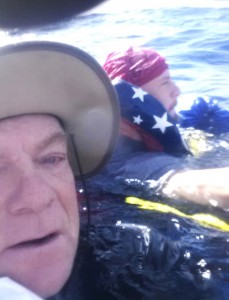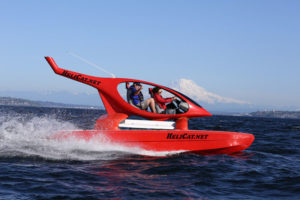Earlier this year the innovative and intriguing Helicat, built by Wordboats, was flying around Puget Sound during sea trials and photo sessions. During an offshore run of Florida about three weeks ago the boat met its demise. Fortunately the company owner Sandy Williamson did not. The story below is from a local Florida news source. There is a bit more to the story regarding the personal locator beacon that saved his life here and here. -KH
From www.browardpalmbeach.com, by Kyle Swenson Thursday, Nov 14 2013

Photo courtesy of Sandy Williamson
Fifteen miles out to sea, Williamson (left) snapped a picture of himself and Whittaker.
Neither land nor rescue craft was in sight. An hour after his 21-foot catamaran had plummeted 2,100 feet to the bottom of the sea, bulky Seattle boat broker Sandy Williamson was treading water in six-foot swells 15 miles off Miami.
Just a few inches away, Corey Whittaker, a wiry and bearded 29-year-old, shivered in the cold water. Without the life jacket, he might have already drowned.
God, I’m stupid, Williamson thought. Then he began to ponder the sharks. If they came, he resolved to act as a decoy.
“I would swim out as far as I could and slash my leg with a pocketknife,” the 60-year-old recalled two days later, tears pouring from his eyes and sobs shaking his thick chest. “He’s got his whole life ahead of him. I’ve had a great life. I’m ready.”
A half-hour before on that cloudy October 27, the two had watched their boat sink. They were floating in the same waters where two weeks earlier, four Haitians had drowned after their 25-foot sport fisher had capsized. Florida leads the nation in boating fatalities.
Williamson is a hearty, adventuresome guy who usually can’t get to the end of a sentence without his ruddy face splitting into a smile. He had been in Florida barely a week, hoping to lure buyers to his unique line of catamarans at the Fort Lauderdale International Boat Show.
Boating had always been center stage in Williamson’s life. He was born on the Atlantic Ocean, in Argentina, and raised just a few miles from the Pacific Coast near Palo Alto. He began sailing with friends in high school, and by the time he was a student at Berkeley, he and his future wife, Debbie, had pooled $1,100 for a sailboat. On their first trip on San Francisco Bay, they towed a disabled boat to shore. “That’s the way it’s always been with me and sailing,” Williamson says. “Trial by fire.”
Soon after graduation, Williamson took a job with the U.S. Geological Survey; he and Debbie did stints in California and Texas before landing in Seattle. In 2010, he retired from government work after 35 years.
The couple opened a boat brokerage. Lately, they’d been pitching the HeliCat, an Argentine 21.5-foot fiberglass catamaran. The two hulls supported a central open cockpit shaped like a bladeless helicopter. Williams bought molds for the design, tweaked the blueprints, and created a 2,200-pound version that could top out at 33 knots on twin 60-horsepower engines. It was a Jet Ski with the stability of a power boat. Price tag: $70,000.
But even after investing $250,000 into the project, Williamson had never taken one for a spin on the open ocean. That’s where Fort Lauderdale and the ill-fated trip to the Gulf Stream came in. This past October, he decided to head to South Florida for the boat show and pilot the HeliCat 50 miles to Bimini. Heck, I’m going to prove this thing can work, he remembers thinking.
But Williamson didn’t want to ride solo, so he sent an email to the local USGS branch asking if anyone would be interested in tagging along. An hour later, his inbox pinged with an answer from Whittaker. For the young field tech, the invite was a chance at random adventure. He often skipped air boats over remote patches of the Everglades, but the sea would be something different.
A little after 8 a.m. Sunday, the pair met at Haulover Marina and boarded the bright-yellow HeliCat. They headed out through the fast waters of Haulover Cut toward a sun wrapped in clouds.
The weather report was iffy: eight- to ten-mile-per-hour winds increasing to ten to 12 by midafternoon, but Williamson figured the HeliCat would slice easily through to Bimini in three and a half hours.
With Williamson at the helm and Whittaker in the back seat, the HeliCat pushed on at a steady 15 knots. Outside of occasional mumbles about the waves, both men were quiet. It was a friendly silence, though, and Williamson recalls thinking the younger man was about same age as his four children.
An hour into the ride, Williamson stopped the HeliCat, and the men took turns balancing on the hulls for a pee break.
When they started again, Williamson checked his Samsung Galaxy to find they still had about 60 percent of the trip left. Then he looked over and was shocked. A 14-by-16-inch hatch had ripped clean off the left hull. As water rushed in, anchor ropes and inflatable fenders gurgled out.
Williamson shouted for Whittaker to turn the boat around so they could look for the missing piece. But as they reversed course, water topped off the storage space, adding 500 pounds to the HeliCat; incoming waves bashed the right hull, and a second hatch was torn away. Now both hulls were filling with water.
Williamson knew his handiwork was done for. Rather than panic, though, he went on autopilot. “Corey,” he said, “get the locator beacon out and press the button.”
“You know that’s going to call the Coast Guard?”
“Yeah, that’s exactly what I want it to do.”
Both men prepared for the water. Whittaker strapped on a life jacket while Williamson collected a length of yellow rope, his duffle, and a flotation cushion. Then the boat capsized. The two men were in the water, tethering together whatever they could collect. It was 9:45 a.m.
This is very bad, Williamson thought. It wasn’t the first time he’d had to think quickly in a dangerous situation. Once he’d been caught in a freak lightning storm while hiking down Mount Rainier. As a teen, he’d been pinned underwater in gushing rapids, frantically waiting for his breath to give out. He had squeaked out of both situations, but now here he was, bobbing in the ocean. This is very bad.
Everything became a calculation. The boat was slowly vanishing into the chasm of the Atlantic. Williamson could dive for his own life vest, but it would burn energy. There was no telling how long they’d be out here. Conservation was key. His cell phone was still powered up in its waterproof case, but there was no signal. The men debated swimming east for service, but that was probably about four miles away. They might drain themselves with the swim, and “then the fucking phone might have gotten wet by then,” Williamson reasoned later.
Text messages might work even if the phone didn’t. So to his brother and wife, Williamson punched out: “911, sunk, 15 mi off.”
By 10:30, the situation had worsened. The boat was gone. “OK, I’m going to pray now,” Williamson called to his comrade while silently beaming up a plea to see his children and grandchildren again.
“Me too.”
The men were quiet. Williamson treaded water, holding tight to the cushion.
Whittaker floated and began to shiver. “I don’t have a lot of body fat,” he would say later. “It was cold.” He was holding the emergency beacon in his right hand, trying desperately to keep it out of the water. To distract himself, he began reading the tiny print. “Oh,” he called over to Williamson, “I’m supposed to pull the antenna out.” He extended the foot-long metal rod and hit the signal again.
Then the men continued their wait.
There were so many what-ifs. The small plastic device might work, or it might not. His family might report him missing. Or maybe not. Rescuers could be en route. And if they were, they might not realize the Gulf Stream had nudged the men north from where the boat went down.
At noon exactly, there was elation. A red dot appeared in the sky and grew into a Coast Guard chopper. Then, as suddenly as it arrived, it buzzed away. The hope deflated.
A minute later, the dot reappeared. It again grew into a chopper. Then it again shrank out of sight.
On the third pass, the chopper hovered directly overhead. Williamson and Whittaker high-fived when the rescue diver hit the waves.
Original story here.
